VIII. The Divine Pharaohs
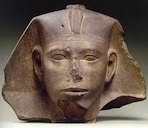
Djedre
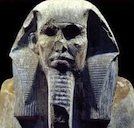
Djoser

Khafre
Popular lecturer and scholar, Peter A. Clayton begins his Chronicle of the Pharaohs: The Reign-by-Reign Record of the Rulers and Dynasties of Ancient Egypt with a Preface called God-Kings of the Nile. “The Egyptian pharaohs,” he says, “were god kings on earth who became gods in their own right at their deaths.” Thus several subjects of scholarly controversy are swept up and presented in a sensible way. Indeed the Pharaohs to some degree were regarded as gods during their reigns; because they undoubtedly became, in the Egyptian identification of them with Osiris himself, gods after death, sequentially they represent another form of henotheism, we might say. As such these human divinities live on in a historical chronology.
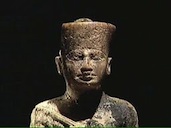
Khufu
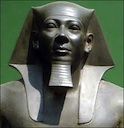
Menkaure
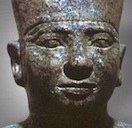
Teti
A more sobering view of the subject is taken by Georges Posener, who, Wilkinson tells us, in his Complete Gods and Goddesses of Ancient Egypt, “showed that the image of the living pharaoh as a god-king is perhaps exaggerated by the royal and religious sources which aim to heighten the divine aspect of kingship. In popular literature and texts the Egyptian king is hardly portrayed as a god. He cannot work the miracles of the wise men and is certainly neither omniscient nor invulnerable as we would expect, if he were regarded as truly divine. From this perspective it would seem that it was not the king who was honored as a god but the incarnate power of the gods that was honored in the king.” Still these figures commanded god-like power.
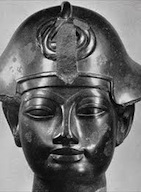
Amenophis III
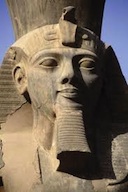
Rameses II
Under the heading, “Deified in life,” Wilkinson in turn further qualifies the view of Posener. “Despite the human-divine duality inherent in the reign of most Egyptian pharaohs,” he writes, “there were instances when living kings do seem to have been declared fully divine within their lifetimes. . . . [T]he living deification of Amenophis III and Rameses II are relatively well attested. In the case of Amenophis III we find that the king began the increasing solarization of Egypt’s major cults and of his own kingship. According to Raymond Johnson “the king declared himself deified and merged with the solar disc, the Aten.” According to Shaw, monuments dating from his reign “name Rameses himself as the god.”
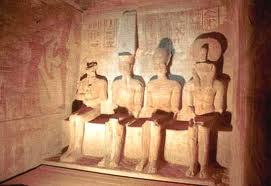
Ptah, Re-Horakhte, Osiris (himself) and Amun-Re
“From this time,” Wilkinson continues, “we find the king taking divine prerogatives in his representations, such as those showing him with the curved beard of the gods, with the horns of Amun and wearing the lunar crescent and sun disc or presenting an offering before a statue of himself. In the inner shrine of the great rock cut temples of Abu Simbel, Rameses III was to do likewise. . . . [Rameses II] had four statues cut to represent Ptah, Re-Horakhte, Oriris (himself) and Amun-Re, seated side by side. That the king is not simply depicted in the company of the gods is clear, since the figures are shown as incontrovertible equals. It has even been suggested that in this group the king might be represented as an embodiment of all these national gods. . . .”
Of great interest for our understanding of ancient Egyptian theology are scenes that survive of kings presenting sacrifices of themselves. Such depictions are based upon the concept of dual (earthly and heavenly) roles played by the gods themselves. Wilkinson: “While what we might call full deification occurred for some monarchs within their lifetimes, it was usually in death that this state, however, was reached and a good deal of evidence seems to show that the deceased Egyptian king was venerated as a ‘full’ god.’. . . The idea of the king’s deified afterlife was certainly established by Old Kingdom times, though, and the same types of textual evidence are found in royal mortuary contexts throughout subsequent periods of history.”
*
In his treatment of the question David P. Silverman has this to say about terminology: “From early times the epithet netjer (ntr) referred directly to the king as a god. Sometimes the term occurred alone; at other times it appeared with modifying or descriptive words. Another epithet from early times referred to the king as a descendant of a god — s’ R’, ‘son of Re.’ Later the Egyptians developed other terms such as tjt, ‘image’ of a god and pr’. This latter, an expression meaning ‘great house’ and referring to the palace, was an abstraction that attributed a corporate nature to the king. . . . Sometimes the king was also referred to as ‘like’ (mj) a deity. Ordinarily all these royal epithets were used in specific types of documents.”
“Unlike traditional deities, the earthly ruler observed jubilees of revivification in order to ensure the land’s fertility. Like a private person, the king required a tomb to ensure his afterlife. Ordinarily gods did not have tombs. Gods could age, but their actual death was rarely recorded. Adding to the complexity of the concept of divine kingship was the development of the cult of the living king, which essentially treated the king like a god while he was still alive. Whereas the gods’ behavior and activities tended to be humanized, they underwent no metamorphosis from one sphere to another, remaining instead constantly divine. The king, by contrast, possessed aspects of the human at some times and of the divine at others.
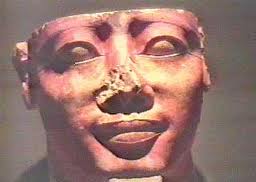
Senwosret I
“He clearly originated in the world of the human, but he could function in both worlds. The gods belonged to an invisible world inhabited only by the divine. They did not ordinarily appear on earth, except in their representations as two- or three-dimensional figures in reliefs or statues. The king operated on earth as an individual active among humanity. . . . Throughout the Old Kingdom the king was said to have the powers of the gods: Hu (divine utterance), Sia (divine knowledge) and Heka (divine energy and knowledge of magic). Later Middle Kingdom representations of the pharaoh, however, often did not display the imperious, detached demeanor that royal images had in the Old Kingdom. The king’s expression was more human.
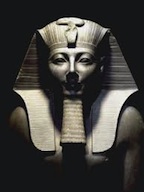
Tutmose III
“During the New Kingdom came an effort to equate the king with the powers of the divine world. Whether the proper description is ‘identification,’ ‘incarnation’ or ‘manifestation,' it is clear that the king had a mortal aspect. . . . The divinity of the dead king is a much less controversial concept than the divinity of the living king, for he was clearly identified in his mortuary image with the god Osiris.” “During his lifetime,” according to Hornung, “the god who is chiefly recognized in the appearance of the king is Re, the creator and preserver of the world. ‘You are Re,’ high officials of the New Kingdom cry out to the king; earlier, in the Middle Kingdom, Amenemhat III is said to be ‘Re, who is seen in his rays.’”